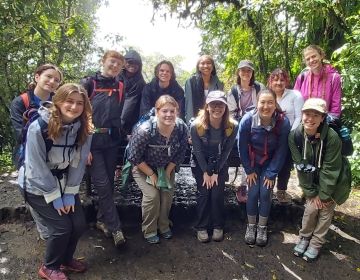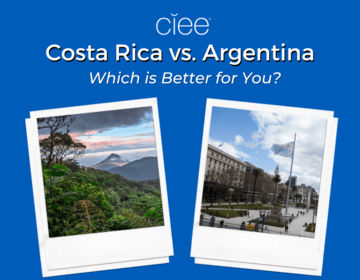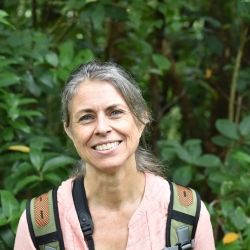CIEE Internship at the Monteverde Friends School: Environmental education reaching all ages, by Emily Bourke (University of North Carolina at Wilmington)
For the past month, I have been interning with the Monteverde Friends School, MFS, as the Environmental Education Assistant. The Monteverde Friends School is a school founded by Quakers back in the 1950s and holds students from kindergarden through twelve grade. The Carbon Neutrality Committee of Monteverde has been working towards making the MFS carbon neutral. Under the guidance of Marcela Morales, fellow intern, Hailey Brown, and I aimed to raise the awareness of the school committee on carbon budgets, the benefits of becoming carbon neutral, and increasing community involvement and commitment.
Hailey and I focused our efforts on creating a workshop for high schoolers, parents and faculty at the MFS. The MFS has 6 big projects on campus that reduce carbon emissions at the school. However, there was a gap in knowledge of how the projects link to carbon neutrality. The workshop aimed to mend the gap.
The sign that Hailey and I made to inform and entice people to attend the workshop. This was posted outside of the office at MFS five days before the workshop and written in English and Spanish.We wanted the workshop to be interactive and engaging for the audience, so we limited our “lecturing” to only key definitions and graphs. We focused on breaking up into small groups for brainstorming about future ideas for the school, and possble improvements to be made at the school and at individual homes. We created a game called “Carbon Neutrality” which broke the group into 4 teams of 6. Each team was given 8 cards with a specific activity written on each; for example, “getting to school”. On the same side as the activity, there were 2 or 3 options to choose from; in this case, “drive”, “walk”, or “carpool”. Based on their choice, the group moved closer or further from a “carbon neutrality” line.
Following the workshop, Hailey and I focused on our individual projects. I chose to educate the younger ages among the school by creating a board game. The game is made out of all recycled materials such as bottle caps, corks, and magazine cut-outs. From the start, the idea of repurposing materials is portrayed. There are four teams that must travel from a crowded, polluted city life (circumference of the circular board), through the pastures and human impacted land, to the pristine forest where carbon neutrality is possible (center of the circle). As teams proceed to the center of the board, there are bottle caps with a (+) or (-) indicating whether to move forward or
backward based on an action explained on a corresponding card. The goal of the board game is to provide a simple yet meaningful way to engage youth into learning about the adult issues of climate change.
A student and his group decide on a final choice while playing the Carbon Neutrality game. Each card had an activity on one side with 2-3 choices. After the choice was chosen, the card was flipped and each choice (A, B, or C) had a corresponding number of steps to take forwards or backwards.Environmental education is a realm that has always interested me throughout my education. I believe that educating people about the current issues we face as humans is the first step needed in order to solve the problems and avoid facing them again in the future. I have always thought of education starting in youth, but education is continuous throughout life, especially with issues that evolve over time such as climate change. Climate change is an issue that all humans face, but when current adults were younger, this issue was not yet on the spectrum of worries. Personally, I feel education is the root of solving current issues. When people genuinely learn about the issues and how to reduce impacts, passions grow increasing the likelihood that change will occur.
A: The board game I created for the MFS. To the side of the board are the two piles of cards- positive and negative cards. Also, there is a bad hand-made by my supervisor labeled “CN” for “Carbon Neutrality”. Inside are the bilingual set of rules and eight playing pieces, two pieces for each color in case one is lost. B: The workshop being presented to the audience of 25 people which included students, faculty, teachers and community members. A Powerpoint presentation and a game were included.
Related Posts

Happy Earth Day: Today and Every Day
Happy Earth Day! Every April 22, this global event comes around to remind us how precious our planet is, what sustainable efforts we can make to protect Earth, and that... keep reading

Costa Rica vs. Argentina: Which is Better for Study Abroad?
Imagine yourself sipping mate in a bustling Buenos Aires café or lounging peacefully in a hammock overlooking Costa Rica's lush rainforests. These contrasting scenes represent just a glimpse of the... keep reading

Top 10 Study Abroad Volunteer Opportunities with CIEE
Have you ever wondered if you could volunteer abroad? Perhaps you're looking into study abroad programs that provide international volunteer opportunities. If you’re itching to study abroad and truly make... keep reading
